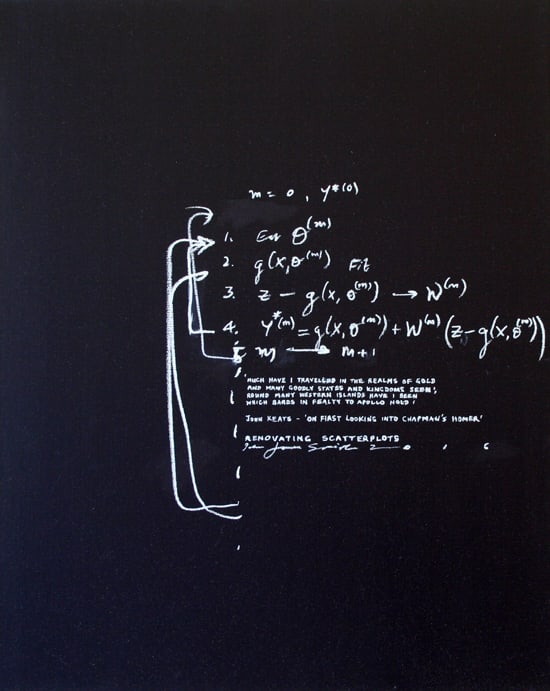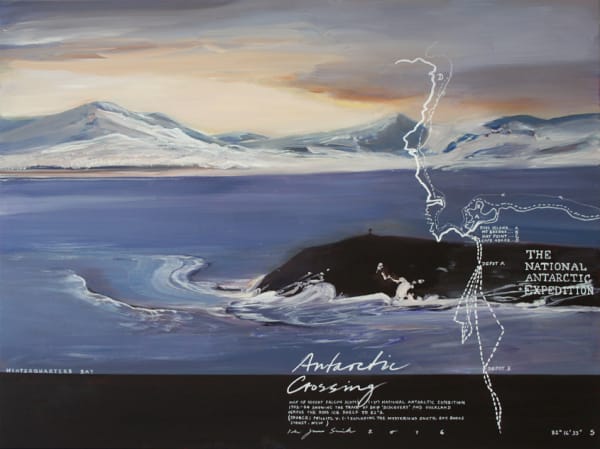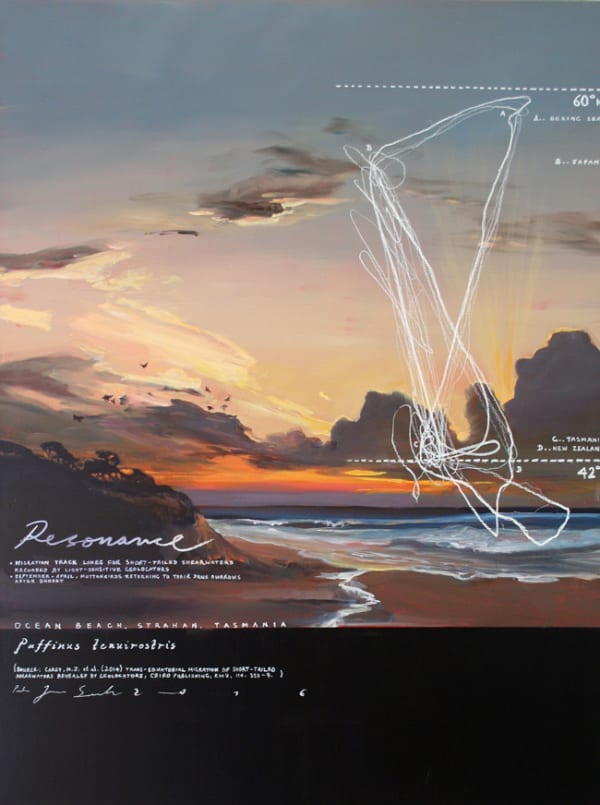Peter James Smith: Line of Sight
L I N E o f S I G H T The current ongoing series of paintings, Line of Sight, is an examination of landscape, place and its relation to the history of that place—this relationship arcs like the tracery of a dotted line—forming a bridge that stretches from where we stand looking in a landscape towards the horizon of history, of scientific and cultural knowledge. The works in this series are an attempt to construct meaning at that time/place nexus using texts in white oil paint overlaid on the painted surface of both paintings and sculptures.
The texts are reprised from diverse sources in a post-modernist tradition. They draw on my time as a professional mathematician writing descriptive formulae on blackboards; they draw on a love of poetry and historical moment; and in this exhibition, they draw on Antarctic history through images of Scott’s Hut and photographs from the Heroic Period of Antarctic exploration. So the texts are cultural constructs of meaning. Then clearly there is the specificity of the general notion of ‘landscape’. It is the landscape that watches over a specific place. It endures. It enfolds the past. It hides past events and lost causes. It slowly covers over tracks like the murderer cleaning up the scene of the perfect crime.
In this exhibition, there are many specific landscapes referenced: Macquarie Island in the Australian Antarctic Territory; Scott’s Hut and Winterquarters Bay, Antarctica; Isle of the Dead and Tasman Island, Tasmania; Greenwich, United Kingdom. I feel the need to travel to a specific landscape and experience its essence before I can paint it—a practice that I term The Geometry of the Lived Experience.
Beyond place and text, there is the actual application of paint. My current practice embraces the traditional painting approaches of oil on linen in a realist style that is at once traditional and contemporary: traditional, in the sense of my fertile interest in the 19th Century High German Romantic paintings of Caspar David Friedrich (1774-1840) or the American Luminists such as Frederic Edwin Church (1826-1900); contemporary, in my embrace of contemporaneity—the linking of images and texts from different times, cultures, knowledge systems, histories and geographic locations—to a painted constellation in the present. The notion of constellation may be enhanced through the traditional salon hang, where works feed off each other and jostle for the eye of the viewer while maintaining an individual essence.
These works, including the sculptural works, continue with the presentation of black formats, margins and facia. These clearly relate to the ‘blackboard’ context, but also notion of the projection of knowledge into a darkened room. This has been a characteristic of past painting practice. According to McCulloch’s Encyclopaedia of Australian Art:
‘His super-real paintings set against dark grounds have been accurately described as ‘cinematic’ in their use of sequential images in which their text and imagery is illuminated as if projected in a darkened room’i .
Continuing a resolve of the last twenty years, many of the works appear as white text in oil over blackened grounds. The texts in Fallen Cross, 2016, show the symbols deployed at MONA in Tasmania for assisting museum visitors locate themselves within the gallery ‘X’ and then add information in relation to nearby artworks ‘+’. The painting acknowledges the change in meaning for these symbols from their mathematical origins as multiplication and addition, to a cut-and-paste context with a sense of almost spiritual loss. There is a powerful fluidity to mathematics: as new technologies require new mathematical insights, old methods are forgotten. Continued fractions, fractions or even handwriting itself are finding few teachers and fewer students. Taken together, Fallen Cross, 2016 and Greenwich Meridian, 2015, set up a tension between science and religion. The man-made crossing at Greenwich becomes a spiritual nexus overpowering the visual image of the ‘X’ marks the spot landscape. i ‘McCulloch, A., McCulloch, S., and McCulloch Childs, E. (2006) The New McCulloch’s Encyclopaedia of AustralianArt, The Miegunyah Press, Melbourne, p.897
-
 Peter James Smithlongitude, 2016oil on linen61 x 122cmAU$ 6,000.00
Peter James Smithlongitude, 2016oil on linen61 x 122cmAU$ 6,000.00 -
 Peter James SmithScott’s Last, 2013oil on linen61 x 76 cmAU$ 3,500.00
Peter James SmithScott’s Last, 2013oil on linen61 x 76 cmAU$ 3,500.00 -
 Peter James SmithSelected Poems MMXVI, 2016oil on books48 x 42 x 28 cmAU$ 2,500.00
Peter James SmithSelected Poems MMXVI, 2016oil on books48 x 42 x 28 cmAU$ 2,500.00 -
 Peter James SmithAntarctica, 2011oil on 10 opened books80 x 100 cmvariableAU$ 2,500.00
Peter James SmithAntarctica, 2011oil on 10 opened books80 x 100 cmvariableAU$ 2,500.00 -
 Peter James SmithHereafter When They Come to Model Heav’n, 2015oil on linen76 x 61 cmAU$ 3,500.00
Peter James SmithHereafter When They Come to Model Heav’n, 2015oil on linen76 x 61 cmAU$ 3,500.00 -
 Peter James SmithThe Emperor’s Silence, 2013oil on linen61 x 76 cmAU$ 3,500.00
Peter James SmithThe Emperor’s Silence, 2013oil on linen61 x 76 cmAU$ 3,500.00 -
 Peter James SmithEndurance Crushed, 2015oil on linen61 x 76 cmSold
Peter James SmithEndurance Crushed, 2015oil on linen61 x 76 cmSold -
 Peter James SmithRenovated Scatterplots, 2016oil on linen76 x 61 cmAU$ 2,500.00
Peter James SmithRenovated Scatterplots, 2016oil on linen76 x 61 cmAU$ 2,500.00 -
 Peter James SmithGreenwich Meridian, 2014oil on linen40 x 50 cmAU$ 2,500.00
Peter James SmithGreenwich Meridian, 2014oil on linen40 x 50 cmAU$ 2,500.00 -
 Peter James SmithThe Magnitude of Starlight, 2013oil on linen92 x 61 cmAU$ 3,000.00
Peter James SmithThe Magnitude of Starlight, 2013oil on linen92 x 61 cmAU$ 3,000.00 -
 Peter James SmithTurbulence: Three Bodies In Relative Motion, 2005oil on linen76 x 61 cmAU$ 2,500.00
Peter James SmithTurbulence: Three Bodies In Relative Motion, 2005oil on linen76 x 61 cmAU$ 2,500.00 -
 Peter James SmithAntarctic Crossing, 2016oil on linen92 x 122cmAU$ 8,000.00
Peter James SmithAntarctic Crossing, 2016oil on linen92 x 122cmAU$ 8,000.00 -
 Peter James SmithResonance, 2016oil on linen122 x 92cmReserved
Peter James SmithResonance, 2016oil on linen122 x 92cmReserved -
 Peter James SmithIce Station, 2013oil on linen31 x 122 cm
Peter James SmithIce Station, 2013oil on linen31 x 122 cm
CURRENTLY NOT EXHIBITEDSold -
 Peter James SmithAfternoon of Kings, 2016oil on linen31 x 122 cmSold
Peter James SmithAfternoon of Kings, 2016oil on linen31 x 122 cmSold -
 Peter James SmithWind Across the Great Southern Ocean, 2016oil on linen61 x 122 cmSold
Peter James SmithWind Across the Great Southern Ocean, 2016oil on linen61 x 122 cmSold -
 Peter James SmithLempriere’s Mark, 2016oil on linen61 x 122 cmSold
Peter James SmithLempriere’s Mark, 2016oil on linen61 x 122 cmSold -
 Peter James SmithAfterglow, 2016oil on linen61 x 91 cmAU$ 4,000.00
Peter James SmithAfterglow, 2016oil on linen61 x 91 cmAU$ 4,000.00 -
 Peter James SmithFallen Cross, 2016oil on linen76 x 61cmAU$ 3,500.00
Peter James SmithFallen Cross, 2016oil on linen76 x 61cmAU$ 3,500.00 -
 Peter James SmithWatch on the Tasman, 2016oil on linen31 x 122 cm
Peter James SmithWatch on the Tasman, 2016oil on linen31 x 122 cm
CURRENTLY NOT EXHIBITEDSold -
 Peter James SmithShooting the Albatross, 2016oil on linen25 x 122 cmSold
Peter James SmithShooting the Albatross, 2016oil on linen25 x 122 cmSold -
 Peter James SmithVoyager Last, 2016oil on linen50 x 40 cmSold
Peter James SmithVoyager Last, 2016oil on linen50 x 40 cmSold -
 Peter James SmithThe Eastern Shore, 2016oil on linen21 x 31 cm
Peter James SmithThe Eastern Shore, 2016oil on linen21 x 31 cm
CURRENTLY NOT EXHIBITEDAU$ 1,000.00























